EXCLUSIVE: Inside a Hindutva hostel: how RSS is rewiring the tribal mind

The Project
- There are 80 million tribals in India.
- The Sangh Parivar is running a major program to Hinduise them through the Vanvasi Kalyan Ashram
- They have more than 70,000 schools and hostels for tribal children.
- VKA\'s hostel in Mollarpur, West Bengal, is one of them
The intention
- There\'s a race to stop Christian missionaries, who also run programs to Christianise tribals
- The VKA schools teach Sanskrit, Indian history and nationalist ideology to tribals
- They also teach them to see Christians and Muslims as enemies
- In the past, this has had tragic outcomes. In Gujarat 2002, tribals played a big part in the post-Godhra riots
More in the story
- The daily life at the VKA hostel
- What do the students feel about living at the hostel?
- How does the school inculcate the Sangh ideology in the students?
- What does the curriculum say about Muslims and Christians?
- What impact does it have on tribal kids? How does it change them? Meet Ghasirom Hebrom
The Vanvasi Kalyan Ashram hostel in Mollarpur, in the Birbhum district of West Bengal, is a symbol of a giant, long-term project that largely escapes mainstream attention.
The interiors of the ashram are decorated to mark the "real" history of India, suppressed in official record.
In the gloomy office where I am received, there are pictures of Guru Tegh Bahadur, Maharana Pratap, Bharat Mata, Ram and Hanuman and Swami Vivekananda. There is one of the Naga rebel Rani Gaidinliue, who led a resistance against the British administration, and the founder of the Vanvasi Kalyan Ashram Balasaheb Deshpande. Everything else is sparse: there are three beds without mattresses, and plastic chairs.
Read- Bharatiyakaran: RSS' 8-point guide to saffronise education
"School textbooks are all wrong," says Sushil Soren, the acharya (teacher) in-charge of the hostel. "We study the history of foreigners - 700 years of Muslim rule, 250 years of British rule, where is our history? Why should we study about Galileo?"
A moment later, he corrects himself. "Well, Galileo is a great scientist, and we should know about great scientists. But this Lord and that Lord? Why is there only one Shivaji Maharaj, there must be many others like him who fought colonisers. If we were such a paradheen (colonised) civilisation, do you think we would have survived for so many thousands of years?"
I tell him that Shivaji, Rana Pratap and the Sikh gurus are standard chapters in school history. But he is unmoved: "The questions they ask in exams are all from Islamic and British history. Shivaji and Maharana Pratap are mentioned for the sake of it, no one bothers to study those chapters."
The Vanvasi Kalyan Ashram
The VKA was established in 1952 in Jashpur in present-day Chhattisgarh by Balasaheb Deshpande, an RSS member, with six children of the Oraon tribe. For more than 25 years, it remained a single-unit outfit, then grew exponentially between 1978 and 1992.
This happened particularly in the areas that have sizeable tribal populations such as Jharkhand, Chhattisgarh, Madhya Pradesh, West Bengal, Bihar, Odisha, the Northeast and the Andaman and Nicobar Islands. These were the years soon after the Emergency, when the Jan Sangh -- the BJP's ancestor -- emerged as a viable alternative to the Congress' excesses.
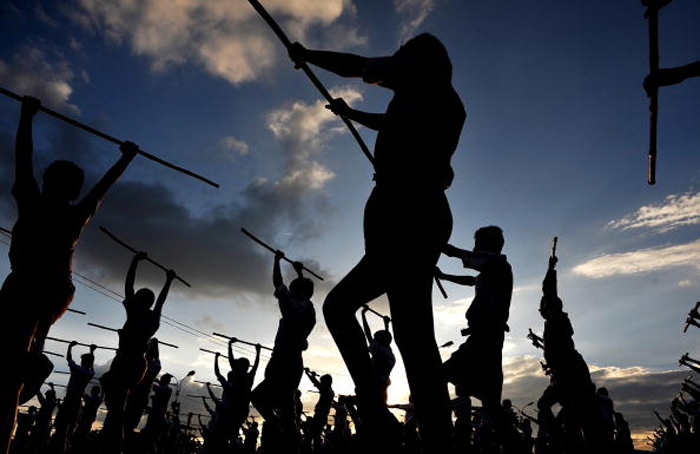
RSS members take part in a physical drill. Photo: Dibyangshu Sarkar/AFP/Getty Images
Today, the VKA says they run a total of 17,808 projects across 28 states and 2 UTs in India. They claim to have made contact with 51,763 tribal villages in the country. By any measure, this is an organisation with impressive reach.
Their principal focus is education although it also undertakes health initiatives and promotes self-help groups. Their stated objective is to rescue tribals from conspirators manipulating them for anti-national activities, such as Maoists, Naxals, and terrorists.
Given its RSS parentage, however, the VKA is widely perceived to be an organisation tasked with recruiting tribals into the Hindutva fold. A 2006 report by the human rights organisation PUCL (People's Union for Civil Liberties) notes how the VKA has "targeted the tribal belts of the country to see that Adivasis lose their identity, culture and traditions of worshipping nature.by asserting that they are Hindus".
It's easy to see why the RSS (or indeed Christian missions) would be interested in this constituency-India is home to 80 million tribals, the largest indigenous population in the world.
VKA runs 17,808 projects and claims to have made contact with 51,763 tribal villages across India
When the VKA has made news, it's been for the wrong reasons. Swami Aseemanand, who was the head of religion at the VKA, is the "accused number one" in the Samjhauta Express blasts case that killed 68. Aseemanand and the VKA were also associated with a series of attacks on churches and missionary schools in the Dangs district of Gujarat in 1998. (The Dangs has a tribal population of 93 per cent.)
In the recent past, Hindutva's encounter with tribals has yielded violent results. The Gujarat riots of 2002 marked the "unprecedented role" of tribals in Hindutva-driven violence. The Justice Tewatia Commission report on the Gujarat riots titled 'Facts Speak for Themselves: Godhra and After Part II' notes: "Earlier in Gujarat, tribals never got involved in the Hindu-Muslim riots."
Also read: 8 RSS think tanks that are competing for intellectual space in Delhi
But little is actually known of the VKA's activities, and this is why I wanted to look. I wanted to find out what they taught at the VKAs, what the texture of life there was like. Do they really draw school children into the fold of Hindutva politics?
Mollarpur hostel: where cakes are deemed dangerous
The organisation's most prided initiative is the hostel scheme where they lodge teenaged tribal boys (there are far fewer hostels for girls) and help them attend school from Class V to Class X, occasionally XII.
The hostels are also one of the VKA's oldest initiatives. On my first day at the Mollarpur hostel, I am given a tour by Soren and his colleagues.
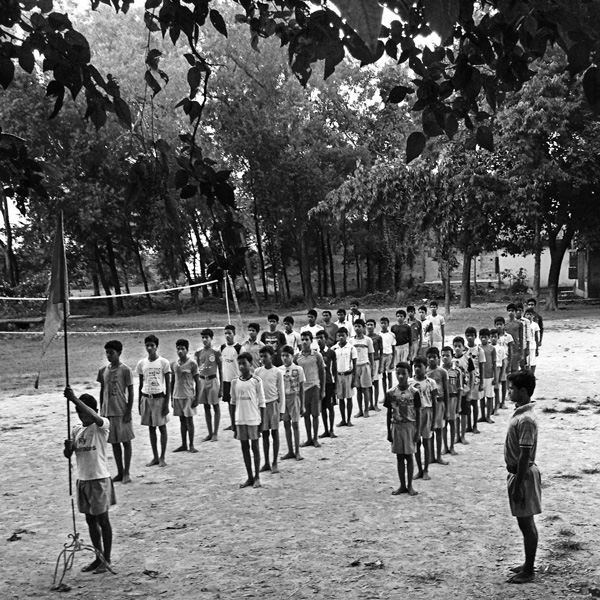
Evening drill at the Mollarpur hostel
The building is an inverted U-shaped structure of one tube-lit room after another. In the prayer room, there is an idol of Saraswati, the Hindu goddess of learning, surrounded by pictures of RSS leaders such as its controversial ideologue MS Golwalkar dubbed the 'guru of hate' by historian Ramachandra Guha, and an assortment of saffron-clad figures, including Swami Vivekananda.
The day starts at 4:30 am and ends at 10 pm, with no exception for Sundays or holidays. Tuitions are organised in Maths, English and Science for the students, but the emphasis is on learning Sanskrit and the history of "Hindustan", which is imparted through daily readings and discussions, and special sessions such as the Rashtra Chintan on Sundays-a 90-minute capsule of Sanskrit lessons, Indian history and nationalist ideology.
For morning, evening and night prayers, the boys recite the Gayatri mantra, or read from the Gita, or other Sanskrit shlokas. (For the longest time, the Gayatri mantra was meant to be recited only by men of the higher castes. Hindu reform movements in the 20th century promoted it being recited by women and other castes as well.) Sanskrit is also used in the mantras in the RSS-style shakha drill in the mornings and evenings, and frequently in the readings in talks and discussions with students.
The concept of the nation-rashtra-underlines everything in the hostel; patriotic songs are part of the daily prayers; the two rounds of shakha are dedicated to the nation; and talks are generally centred on the nation. As the usage of "Hindustan" suggests, this idea is conflated with Hinduism.
The entire ambience is distinctly oriented towards an upper-caste Hindu, literally Sanskritised, culture. There is nothing that suggests tribal, or Santhal, culture, save a couple of photographs of Siddhu and Kanu, who led what is now considered the first rebellion against the British in 1855, and Birsa Munda, who revolted against the British in 1894.
VKA's Swami Aseemanand is the prime accused in the Samjhauta Express blasts that killed 68 people
The Santhals are the largest tribe in the eastern region, and among the largest tribes in the country. But even the picture of Siddhu and Kano that hangs in the hostel is a curious thing, my local guide Buddhadeb Lohar points out. The picture shows them praying in front of a Shiv linga.
The Santhal god, Marang Guru-the god of the mountain-is often identified as Shiva (the god who lives atop the Kailash Parbat), but crucially, the Santhals do not represent the Marang Guru in the form of the linga.
Soren said they sing Santhal songs in the hostel occasionally, but according to the students 'occasionally' meant the annual Hool Diwas function to celebrate Sidhu and Kano's march.
Read more: Ashok Singhal is dead. Who will lead VHP now?
Soren is a fit man in his early thirties, who sits straight like he is performing a yoga asana. He studied in the Mollarpur hostel of the Vanvasi Kalyan Ashram (VKA) himself from 1992 to 2000. He is a pleasant but careful man. He asks me repeatedly, "What is your purpose? Why do you want to write about us? Are you writing about other organisations who work with tribals? What do you do exactly?"
I had decided from the start to be open about my identity as a journalist and writer but
I feel besieged by the questions, and nervous, and don't take out my tape-recorder the first day.
The town
Mollarpur is a sweaty pimple of a town in Birbhum. Last year, when I was reporting the gangrape of a tribal girl in Subalpur village in Birbhum district, allegedly ordered by the village council because the girl had a Muslim lover, I was surprised by the sharp anti-Muslim sentiment among the Santhals there.
Santhal activist Kunal Deb, who mobilised a successful protest against the stone mines in the district in 2010, had told me some of this anger had its roots in the work of the RSS schools in the district. And some of it in the aggression of the Muslim community emboldened by their political clout in the district after the Mamta Banerjee-led Trinamool congress came to power.
Also read: Here's a reminder of what a Hindutva 'nuclear bomb' looks like
Earlier this year, there was a report of tribal Christians re-converting to Hinduism at a yagna ceremony organised by the Vishwa Hindu Parishad in Birbhum. Although both the police and the party denied any reconversion having taken place, the report is troubling.
The district has a significant population of Muslims --37.06% in the 2011 census -- and tribals --7.48% in 2011. But Hindus (62.29%) are the majority.
Birbhum is home to the brutal stone mining industry dominated by Muslim and Hindu proprietors, where Santhals are exploited horribly. And although both Hindus and Muslims own stone mines today, the industry has a reputation for being Muslim-dominated. The mistrust between the communities is prime for the picking.
The RSS has old and deep connections with Bengal. The Nazi-supporting ideologue of the RSS MS Golwalkar was a member of the Rama Krishna Mission in Bengal. The BJP's predecessor, the Jan Sangh, was set up in Kolkata by Shyama Prasad Mookerjee. More recently, as an excellent cover story in The Caravan magazine reported, Swami Aseemanand firmed up his convictions in the RSS shakhas in the state. Incidentally, he too had an association with the Rama Krishna Mission before he found his groove in the RSS.
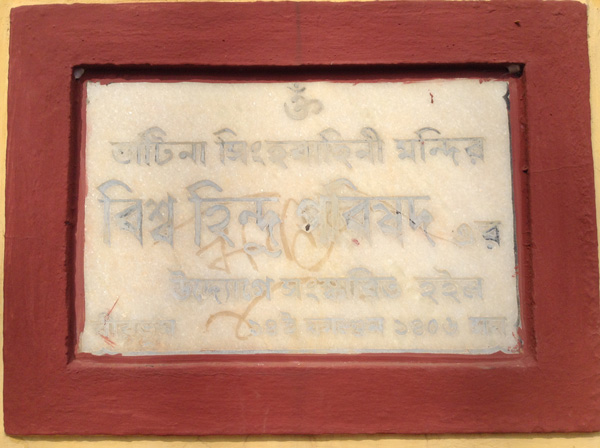
VHP temple dedicated to Singhabahini
The Vanvasi Kalyan Ashram has been operational in Bengal since 1978. The hostels act as nodal points for the VKA ecology in a district, overseeing the shishu shiksha sadans (nurseries) and night schools. There are 14 hostels across Bengal-11 for boys and three for girls. Twelve of these were set up between 1978 and 1992.
However, a momentum has started to gather over the past five years, Shankar Lal Agarwal, the secretary of the Purvanchal Kalyan Ashram, tells me with satisfaction in his electrical goods store in central Kolkata. "Earlier, we had to convince the tribals to send their children to us. There were barely 15-20 students per hostel. Now there are so many aspirants, they have to take entrance exams."
Not all of this momentum is the VKA's doing. Someswar Boral, who has been reporting for The Times of India from the district for close to a decade, feels an interest in education has grown among the Santhals rather than the reputation of the VKA. "This is, in fact, the impact of the UPA's policies. The MGNREGA has meant wider circulation of money overall and Santhals, who are among the poorest in society, have also benefitted. Thinking about education is one of the first impacts of development."
The curriculum - how to be a good Hindu
Despite repeated requests, I was granted very limited access to the boys in the Mollarpur hostel. The teachers, however, were free with their time. They spent two afternoons and one evening offering me a carefully curated introduction to their world.
On the first day, there was Soren and his colleague Narayan Hembrom, and a couple of volunteers. They were frank about their dislike for Muslims and Christians, referring to them as foreigners.
Read: Do you know that nearly 3,000 RSS members eat beef and the Sangh is OK with it
The curriculum at the hostel made clear what they thought of Muslims. Consider this story printed in an ashram study module. A hunter once caught a large tiger and brought it before the emperor Aurangzeb. The emperor declared a more dangerous tiger could not be found on land. One of his courtiers, Raja Jaswant Singh, says he possesses an even more dangerous tiger. The emperor agrees to a duel between the two tigers. The next day, the Raja brings his ten-year-old son Prithvi Singh. The emperor is taken aback but asks for the duel to proceed. When the tiger is let loose, prince Prithvi draws his sword. But his father orders him to throw it aside, because a "dharma yuddha" demands that they fight on equal terms. The prince puts away the sword and tears the tiger into two parts.
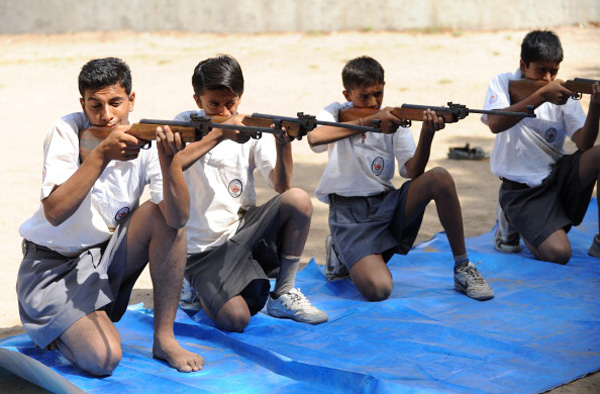
Bajrang Dal volunteers undergoing air riffle training session. Photo: Sam Panthaky/AFP/Getty Images
Consider what the story says about the courage, and fairness of the Hindu raja and prince, and what it does about the ego of an emperor who allowed a ten-year-old to fight a tiger. The impact of classroom discussions based on stories like this cannot be overestimated - as we saw first-hand a little later.
But Muslims are not the only ones despised and hated. The work of Christian missionaries with tribals makes Soren smirk: "Indians need a visa to go to Nagaland and Mizoram and Arunachal Pradesh," he says. "My colleagues who teach there tell me we have become foreigners in our own land." (All Indian citizens need an Inner Line Permit to travel to Nagaland, Mizoram and Arunachal Pradesh, except residents of these states.)
The organisation's most prided initiative is the hostel scheme where they lodge teenaged tribal boys
At this, Kalikinkar Banerjee, a volunteer with the VKA who runs a pharmacy in Mollarpur, says, "Yes, yes, everywhere you see foreign habits." He is a small man with watery eyes, which shine with concentration. "Like people cutting cakes on their birthdays or on Christmas."
"Surely there's nothing wrong with cutting a cake," I laugh.
"But is there anything good about cutting cakes?" he asks. I have never encountered anger against cake before. I smile nervously. (They frequently say funny things here, but they don't laugh.)
What also emerges from the hostel is a deep, intrinsic contempt for tribals. "Go to a Santhal home and see," Soren says, "They will come out to meet you half-naked, in a gamchha (traditional cotton towel), their hair uncombed. We teach the boys to dress properly, to be respectful of guests. Once they go back from here, they are completely different from their neighbours. When I visit their villages, Santhal families beg me to take their sons into the hostel."
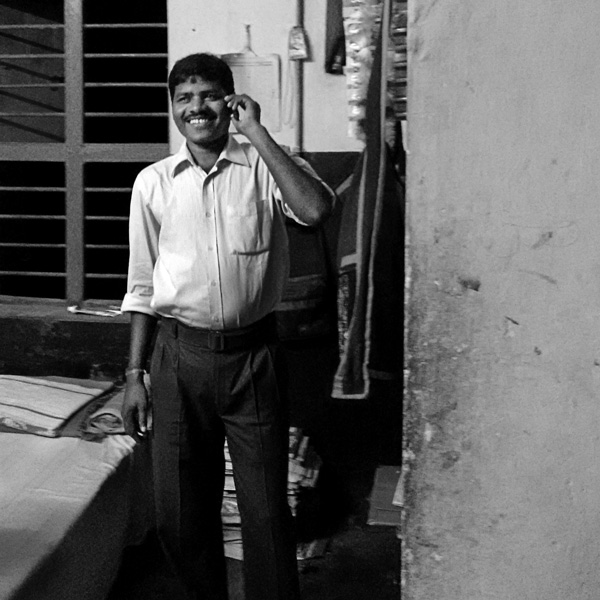
Sushil Soren, the teacher-in-charge of the Mollarpur hostel of the VKA
Soren himself is a Santhal from the nearby village of Gowala. He is the perfect Vanvasi Kalyan Ashram showcase-a student who rose to be a teacher in the same institution. When he speaks of his Santhal background, he refers to it as a handicap, a difficulty that he successfully surmounted. "I was determined from the start that I have to make it; that I must be able to stand up in society like other people. Why is it that Santhals are weak in studies? Why don't they finish school?"
His colleague Narayan Hembrom, who is also Santhal, is even more explicit. He was not a student of the VKA, but has been working with the organisation for six years now. "My parents were murkho (idiots)," he says.
"Surely you mean unlettered," I say. Soren laughs at the suggestion. Hembrom smiles but does not correct himself.
The VKA's use of the term Vanvasi is interesting. And deliberate. They take issue with the term 'Adivasi' - which means indigenous -- calling it a British interpretation meant to wedge a divide among Indians. "If they are the original residents of India, then where do you come from?" Soren asks me. "Are you from the US or England?"
Vanvasi, on the other hand, is meant to be denominative-describing tribals by their forest habitat. But the term vanvasi is not very far from junglee, says Deb, encompassing many of the things Soren and Hembrom mention: half-naked, idiots, unkempt. In other words, uncivilised.
Outside in the courtyard, boys are washing up and gathering around in clumps. I am surprised by their presence: the afternoon has proceeded far too quietly for there to be so many boys in the building. It is time for the evening shakha exercises, and Soren gives us permission to watch.
The tubelight has been on all afternoon in the office, but outside the light is lovely and clean. All the boys are dressed in baggy khaki shorts with a broad folded seam, one half of the instantly-recognisable RSS uniform of white shirt and khaki shorts and black cap. Here, they are paired with shiny football jerseys. Soon, they line up before a saffron bhagwa flag and, after a saluted pledge, perform the surya namaskaar reciting Sanskrit mantras to the accompaniment of whistles.
The RSS imprint is unmistakable, yet somehow the disturbing history of the RSS seems distanced. Here, the chants lift into the air with a sort of melody, that happy chorus of noise every school produces, and the October evening looks handsome in the last light of day.
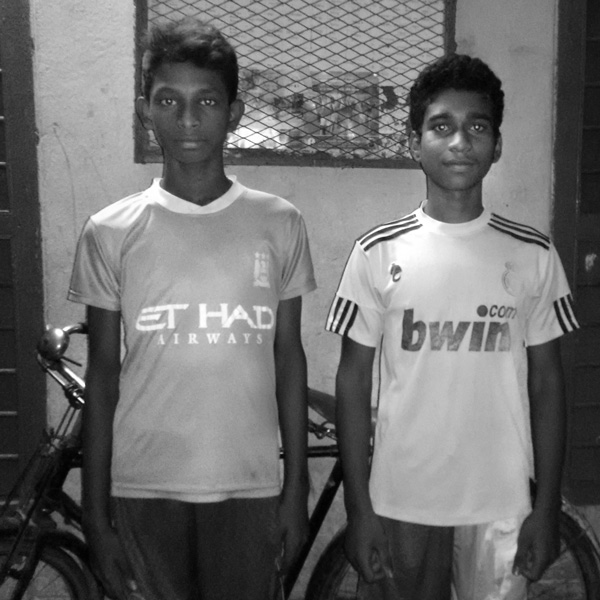
Subhas Hansda and Ajay Mandi, students at VKA hostel
Suddenly a boy with a mop of loose curls and the brink of a grin appears next to me. Ajay Mandi, Class VII student, Real Madrid fan and possessed of a spontaneous cool cat charm, has been excused from shakha activities so he can help chop vegetables for dinner. I ask him whether he likes it here. He nods, breaking into a broad grin.
"What do you like?"
"Studying, playing," he says, then hesitates a moment and wrinkles his nose. "But they don't let us play."
Too much to study?
He shakes his head, and hesitates again. "Studying is fine. No, too much control. we don't get a moment free. They don't let us be," he says
Christians and Muslims as enemies
The next afternoon, Buddhadeb and I are invited to lunch at the Mollarpur hostel. I had an invitation to stay overnight, but I felt unnerved by the place and did not take it up. Lunch was a brief, unsmiling, affair-rice, thin dal, cooked vegetables and a salad of sliced cucumber and tomato.
After lunch, we are led to the reception office again. The windows are shuttered. A man in a white vest and a white garment worn like a South India veshti sits in the gloom.
Also read- RSS's new mission: Bhagwat's ATMA eyes Hindu temples
Mohitosh Gole is head of the eastern wing of the Vanvasi Kalyan Ashram, overseeing work for West Bengal, Odisha, Sikkim, and the Andaman and Nicobar Islands. He is Soren's boss. He is listening to an address on service to the nation when we are ushered in, and switches it off only when I ask what the talk is about.
"Have you heard of the RSS? This is a talk given by one of the pracharaks," he says. "But you tell me first. I'm still not clear what you are doing here. Is this your first visit to the area?"
I explain myself for the fourth time in my interaction with the VKA. But Gole is unimpressed: "How long have you been interested in the subject?" he asks. "Did you start work before you came here? This is not the kind of thing you can understand if you just drop by. Are we the first organisation you are visiting?"
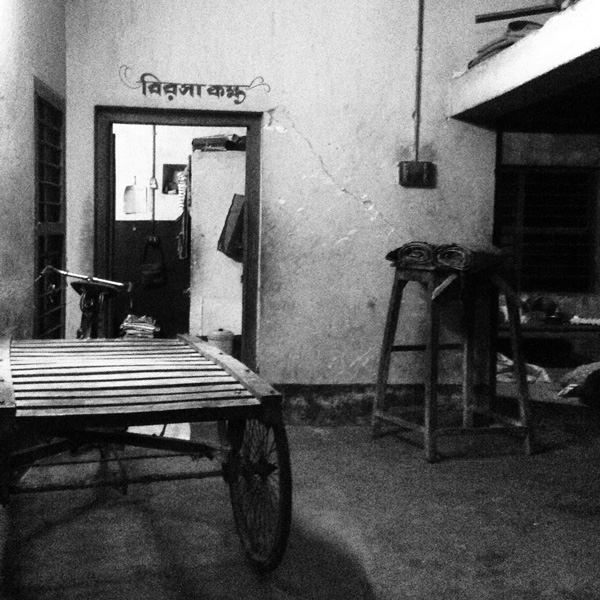
Inside the Vanavasi hostel
Suddenly my anxiety gives way to impatience. I head straight to a pointed question. A large poster on the wall notes the objectives of the VKA. One of these is phrased intriguingly: "To make tribals beware of those working in disguise in tribal society towards unpatriotic ends." Who are these people in disguise, I ask, do they refer to Maoists or Naxals?
"No, no. Wherever there are Christians," he says, without hesitating, "there are anti-national activities. And wherever Muslims are the majority community, there are problems-social problems. It is becoming difficult to live in these places. We make our students aware of these things, so that there are no conversions. But we also tell their guardians. It is not only the students we care about. We want this message to reach their villages -- that is the main thing.
"We don't object to Muslims and Christians, but these days it is becoming so difficult to tell their intentions. A Muslim will come to your house, and you feed them, give them a room to stay, and the next day, they marry your daughter. There are so many incidents like this here.
"Christian missionaries have also started changing their strategy now," he continues. "They don't ask Santhals to change their culture overnight. But over time, the converts move away from their tradition, from the mool srot (the mainstream). This is what we want people to guard against."
Interest in education has grown among Santhals because they benefited from UPA schemes like MGNREGA
"The main thing," Gole says, "is to evoke the sense of being Hindu. The Vanvasi Kalyan Ashram focusses specifically on tribals. But ideally, we want to evoke this sense among everyone, including Muslims and Christians. This is Hindustan, after all; everyone is Hindu first, then Muslim or Christian. If you go to Germany or Japan, everyone says they are German or Japanese, not Muslim or Christian." (The references he cites are interesting: both Germany and Japan have a history of Fascism.)
"The atmosphere here is so polarised! Have you heard about Mission 2020? The Christians have targeted that by year 2020, they will reach all the tribal areas to convert them to Christianity. (The Christian population of Birbhum is 0.31% according to the 2011 Census, they were 0.24% in the 2001 census.) The Muslims have their own plan to convert not only tribals, but also backward classes."
And all this has to be achieved by 2020, I ask.
"That is the target, yes. They want to get as many people as they can converted by then," he says.
Christians and Muslims as enemies
On my first afternoon in Mollarpur, I meet Santhal activist Ghasiram Hembrom in the dusty eating hall of Udita Lodge with red plastic chairs.
I first met Hembrom when I was reporting on the gangrape in Subalpur. He delights in his Santhal heritage, and is an intelligent, articulate man with a broad smile that spills often into a laugh. I am surprised to learn he studied in a VKA ashram.
"From dawn to night, they made us recite mantras to make us forget our own culture. So that they could pull us into the Hindu fold, and deny we have our own distinct culture," Hembrom says.
He studied in the VKA from 1987 to 1992, the incendiary years leading up to LK Advani's nationwide rath yatra and the Babri Masjid demolition. At his hostel, they listened to hours of discussions on Ram and the coming of Ram Rajya. They participated in a campaign to collect bricks from the Santhal villages in the area to contribute to the Ram Mandir in Ayodhya. Hembrom was one of the exemplary students selected for a special 20-day RSS training camp where they were trained in lathi khela, a traditional Bengali martial art involving sticks and other forms of homegrown combat, to defend the nation against foreigners.
The curriculum at the hostel made clear what they thought of Muslims
"It took me years to be able to look at a Muslim or a Christian without getting angry. I used to want to smash their faces as a boy," Hembrom says.
"Why did you want to do that?"
"Because I used to believe that they were on my land. They were taking away what was mine."
The Vanvasi Kalyan Ashram insists that all "Vanvasis" are actually Hindus. The question of whether tribals are Hindus is an ongoing debate. The scholar Amita Baviskar notes how the Indian government classified Scheduled Tribes as "animist" in the colonial period and "Hindu" after Independence under the influence of "nationalist anthropologists".

Bajranj Dal volunteer takes part in an obstacle crossing drill. Photo: Sam Panthaky/AFP/GettyImages
There are, of course, certain clearly visible differences despite years of acculturation. Santhals are nature-worshippers, for instance, and did not originally pray before idols. Today, it is not uncommon to see Saraswati puja being celebrated in Santhal villages. Even so, the vast majority of Hindu pujas are not celebrated by Santhals. The Durga puja in Bengal, for instance, is a time of mourning for Santhals. They believe their king Hudur Durga was done out of his kingdom by the Hindu goddess Durga who tricked him with her beauty and charm. This king is the Asura we see fallen at the feet of the ten-armed goddess.
The Santhal tradition during the Puja is to perform the Dasai Naach, where men dance in villages dressed as women, in search of their lost king. You have not been forgotten, they dance to say, come back and lead us again. Yet, the teachers at the Mollarpur hostel maintain that the DasaiNaach is performed by Santhals to welcome Durga home. What is interesting is the VKA's insistence that Santhal customs represent a continuity with Hindu practices.
Read: VHP to relaunch Ram Mandir movement
"It took me years to see I had so much to love and cherish of my own," Hembrom says. "Years of inferiority had built up, years of being told we are backward and need to be brought into the mainstream. My own world was rich and refined, not only in song and dance, but also in medicine and literature, in the understanding of environment, social justice and equity. Even now some Hindu families wash their homes if a Santhal visits. This is the Hindu idea of being sabhya -- civilised. Come to my home, or any Santhal home, and see how we treat guests. Anyone who comes by is asked to stay for lunch, no matter how poor we are."
Hembrom is a compelling speaker and some of his zeal, I thought, comes from his anger. But at the Mollarpur Higher Secondary School, run by the government, I find surprising validation for his views.
Mollarpur High School has 1,189 students, of which 161 are tribal. Some of the VKA hostelers study here.
We stop by the school at 1 pm on a Saturday. There is a terrific clatter of activity in the staff room. The school committee secretary, Dhiren Banerjee, a local Trinamool Congress representative, is overseeing preparations for an exam at the school. But he is a gracious host, generous with his views and tea.
Head of VKA's Eastern wing says anti-national activities take place wherever there are Christians
"The Kalyan Ashrams are doing what the Christian missionaries do-proselytising. Only, there was a reason why the Christian missionaries found a captive flock. Varna Hindus - caste Hindus - have always treated Adivasis horribly. I've worked in the Mollarpur area for more than 30 years, and I know how we treat Adivasis. You see villages with shining roads and electricity, and 200 feet away there is an Adivasi village which is pitch black. We never call them to our functions, we have nothing to do with them except give them work as labourers.
"I do not oppose the missionaries because they've helped tribals much more than we have," he continues. "If there are doctors and teachers among them today, it is because of the Christians. I do not oppose the VKA's education programmes either. Sanskrit is a refined language, but I know the purpose with which it is being taught there. If you ask me, the ashrams haven't been very successful educating students."
Sarmila Mukherjee, who teaches English in the school, has been following our conversation with interest. I ask her whether she knows any of the students from the Kalyan Ashram. "Oh, many of them," she says. "They are very average; in fact I would say they underperform compared with other students, even tribal students. I always find them very tired."
The students -- how the Hindus are going 'down'
Late one evening after repeated requests, I'm allowed to speak to the boys in the Kalyan Ashram. At first, Gole is present, stage-directing the proceedings. "Introduce yourself, recite a shloka, say namaskaar, stand in a line!" But finally he is persuaded that the boys will be freer in his absence.
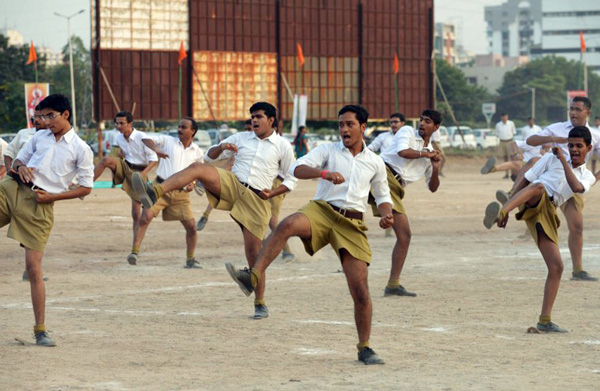
RSS volunteers during a drill. Photo: Sam Panthaky/AFP
I ask to speak with Ajay Mandi, the bright-eyed boy with a relaxed, unafraid curiosity, and Subhas Hansda, a quiet, stiff boy who looks the opposite of Mandi. They are both in Class VII, about 14 years old.
I had underestimated the effort it takes to interview kids. We discuss Bollywood and football and marriage plans. The answers are monosyllabic though the prospect of marriage brings forth chuckles and Real Madrid prompts a whole sentence.
Sushil Soren, a VKA product who rose to become a teacher, considers his Santhal background a handicap
I take a gamble and ask them what they learn about Muslims here. The boys are quiet at first. Buddhadeb makes it simpler: do you like Muslims?
"Their behaviour is different, they are jealous of us," says Mandi.
"How do you mean jealous?"
"They can't stand us Hindus," he says.
"Don't you have any Muslim friends?"
Mandi nods, then says, "But he's also like that. You see, Muslims in cities are slightly different, but in the villages.," he trails off
Do you think India should have room for Muslims and Christians?
"This was the land of Hindutva," says Mandi. "That is why it was called Hindustan. But our constitution says all religions are equal, so we have to live with Muslims and Christians."
"Do you think Hindus should have greater rights then, above the others, in India?"
Watch: Meet the cow protectors: men who'd kill in its name. A video diary
He thinks a moment and says: "Earlier there were many Hindus here. Now, day by day, the number of Hindus are going down."
Later, when I play the transcript again, I notice these are the questions they answer with the least prompting, as if they are confident of their answers.
At the time of the interview though, I didn't notice. These are the questions I had wanted to ask them, and when they were answered, I felt strangely impatient. Not angry, not disappointed as I'd imagined I might be. I just knew that I wanted to leave.
The views expressed here are personal and do not necessarily reflect those of the organisation.
More in Catch:
It's dangerous to make Oscars predictions. But here's our Best Foreign Film longlist anyway
Arunachal govt in trouble: 22 Cong MLAs align with BJP, party blames Centre
First published: 17 December 2015, 20:15 IST




![BJP's Kapil Mishra recreates Shankar Mahadevan’s ‘Breathless’ song to highlight Delhi pollution [WATCH] BJP's Kapil Mishra recreates Shankar Mahadevan’s ‘Breathless’ song to highlight Delhi pollution [WATCH]](https://images.catchnews.com/upload/2022/11/03/kapil-mishra_240884_300x172.png)

![Anupam Kher shares pictures of his toned body on 67th birthday [MUST SEE] Anupam Kher shares pictures of his toned body on 67th birthday [MUST SEE]](https://images.catchnews.com/upload/2022/03/07/Anupam_kher_231145_300x172.jpg)






